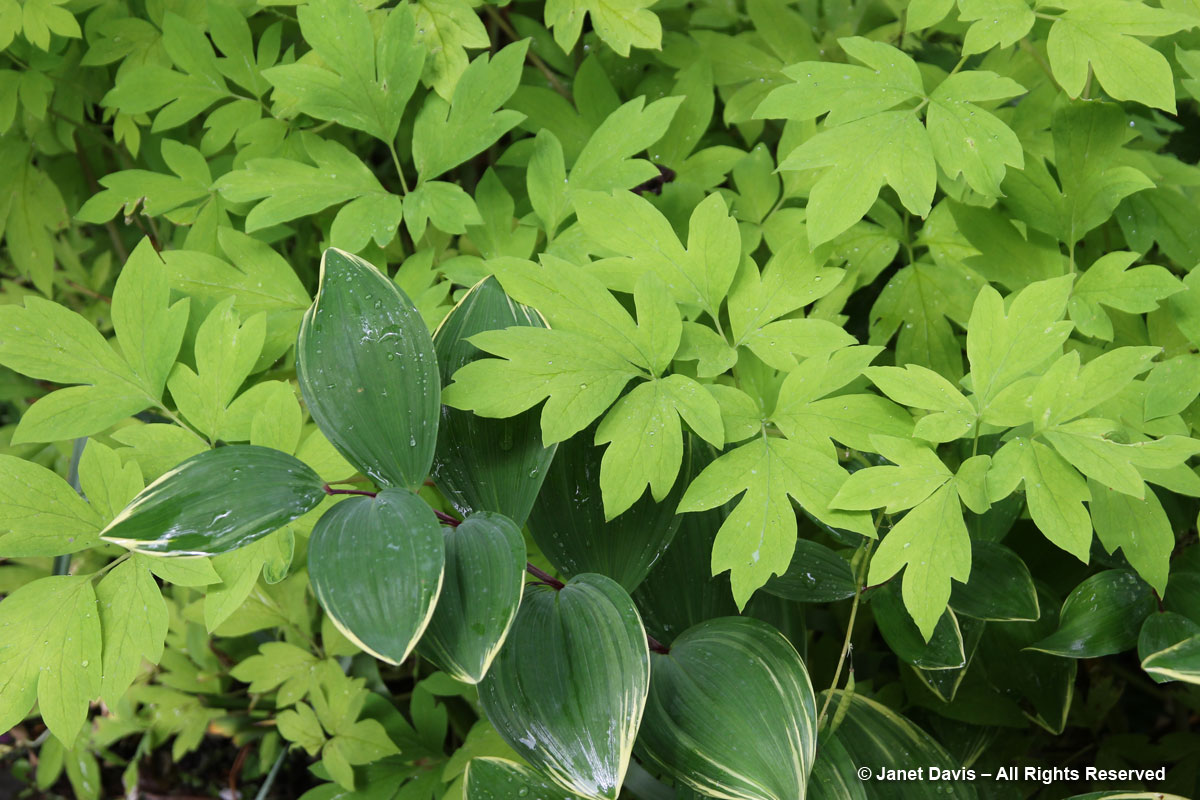Unlike most of my Paintbox Garden ruminations on colour, this one has a slightly more whimsical, personal approach. After all, March (my scheduled green month via my New Year’s resolution), contains St. Patrick’s Day — so two birds with one blog. 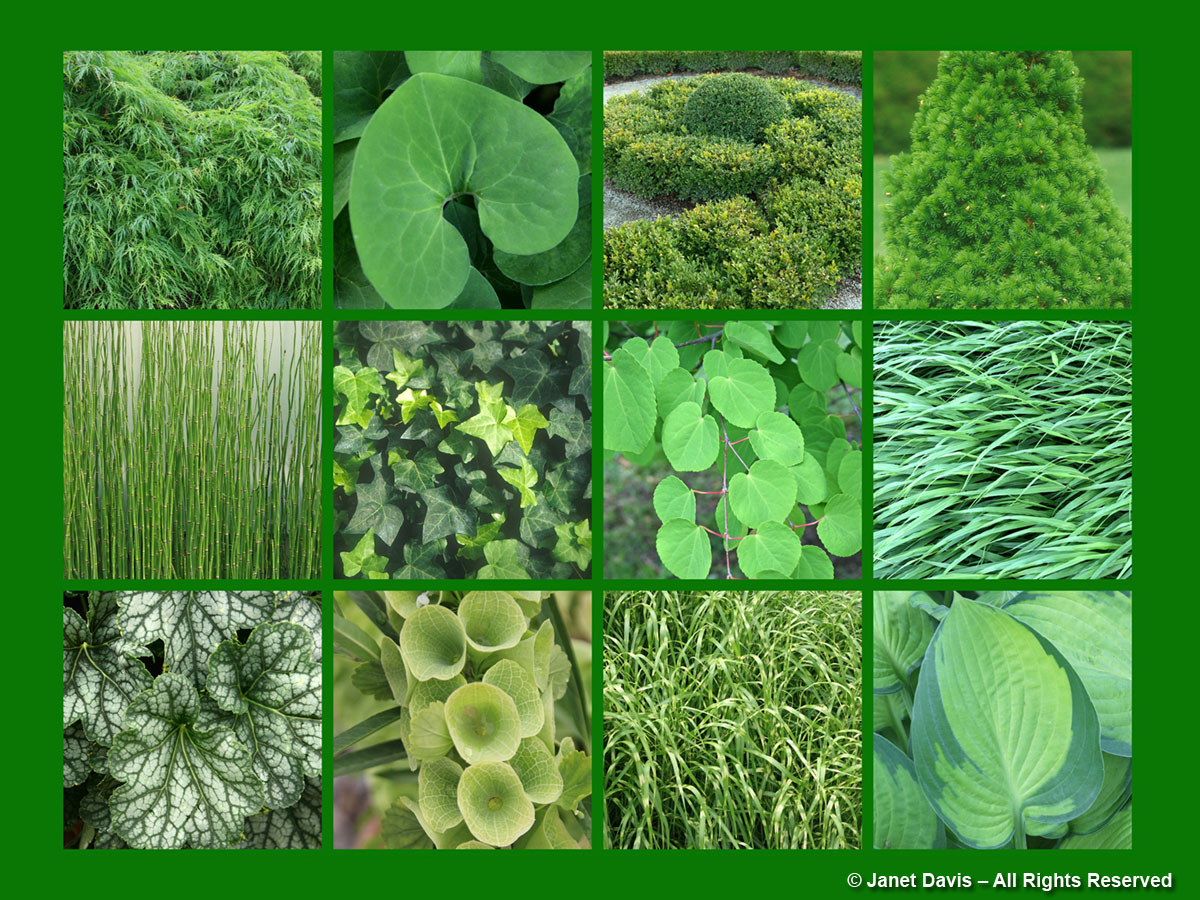 Ask anyone in my family what my favourite colour is, and they will all know the answer: green. My bedroom walls are kiwi-green; my kitchen is celery-green; our summer cottage is stained sage-green. Even my car is forest-green.
Ask anyone in my family what my favourite colour is, and they will all know the answer: green. My bedroom walls are kiwi-green; my kitchen is celery-green; our summer cottage is stained sage-green. Even my car is forest-green. 
My clothes (many of them, anyway) are shades of green, from bright chartreuse to olive, no matter the season. 
Perhaps my passion for green comes from having family roots on the Emerald Isle. This pile of stone and slate is all that remained of my grandfather’s childhood home and blacksmith stable in what was once Kilkinamurry, near Banbridge, County Down, in Northern Ireland. I took the photo when we visited the ‘old country’ in 2008. But look at those lovely spring-green fields! Green as in Ireland!
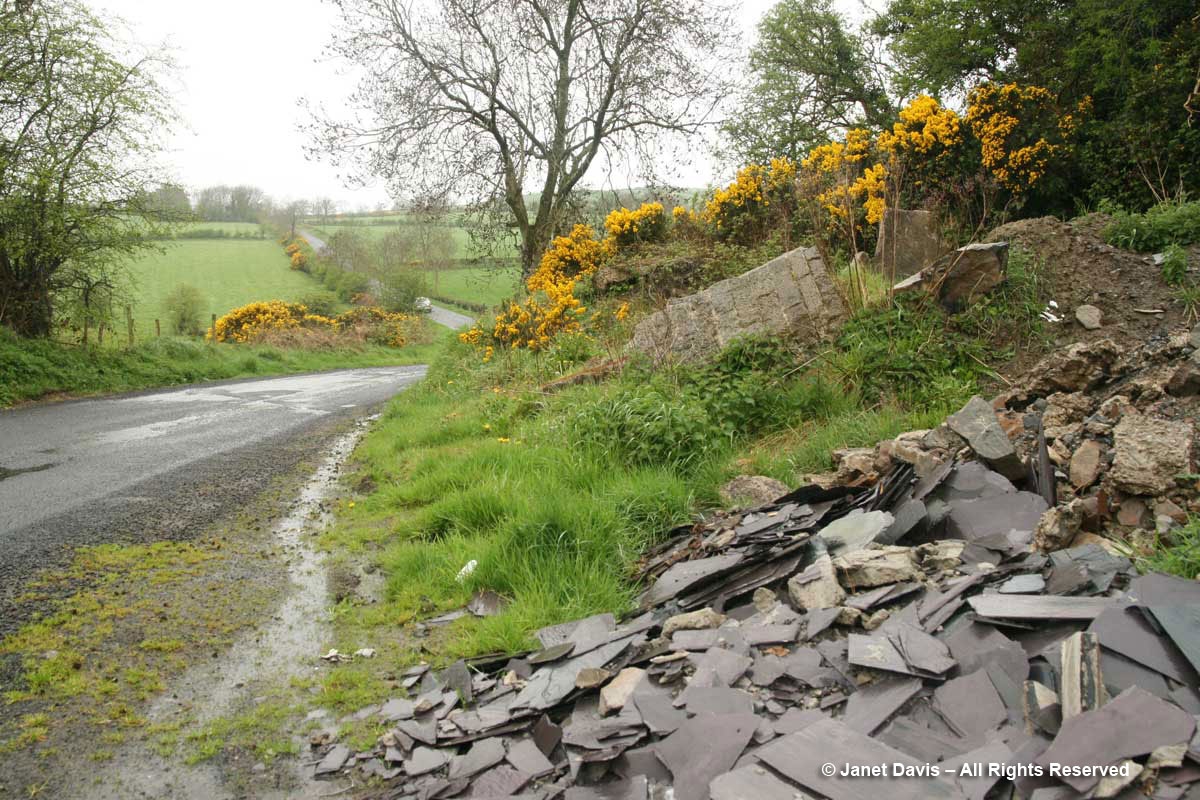
The old Campbell house and blacksmith shop on Glen Corner, as we found it in May 2008 on our trip around Northern Ireland.
This (below) is how it looked in 1917. My great-grandmother Ellen Ann, the gardener, and great-grandfather Patrick Campbell are there in the centre, with some of their children and grandchildren around them, the men in their blacksmith aprons. My grandfather, also named Patrick (Paddy) Campbell and also a blacksmith, had already immigrated to Canada in 1911.
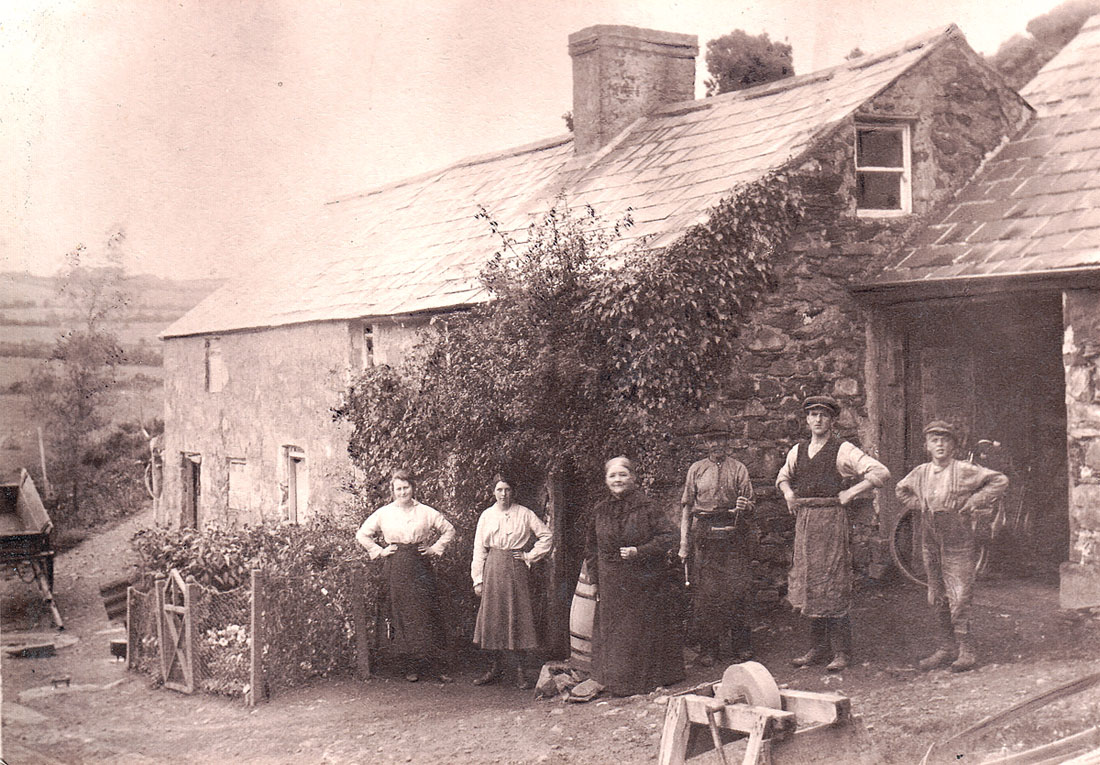
From left, daughter Maggie (m. Cooney), granddaughter Minnie McIvor, Ellen Ann, Patrick, son James and grandson Willie (Bill) McIvor.
Yes, Paddy Campbell. Perhaps I’m drawn to green for the love of gardening I inherited from my grandfather, seen here listening to 11-year-old (bossy? eager? young gardener?) me in his vegetable patch in Saskatoon, Saskatchewan, when we would visit from the west coast for our summer vacations. (That’s my uncle Vic and cousin Debbie in the background). If gardening is in the genes, I proudly claim a share of his DNA.
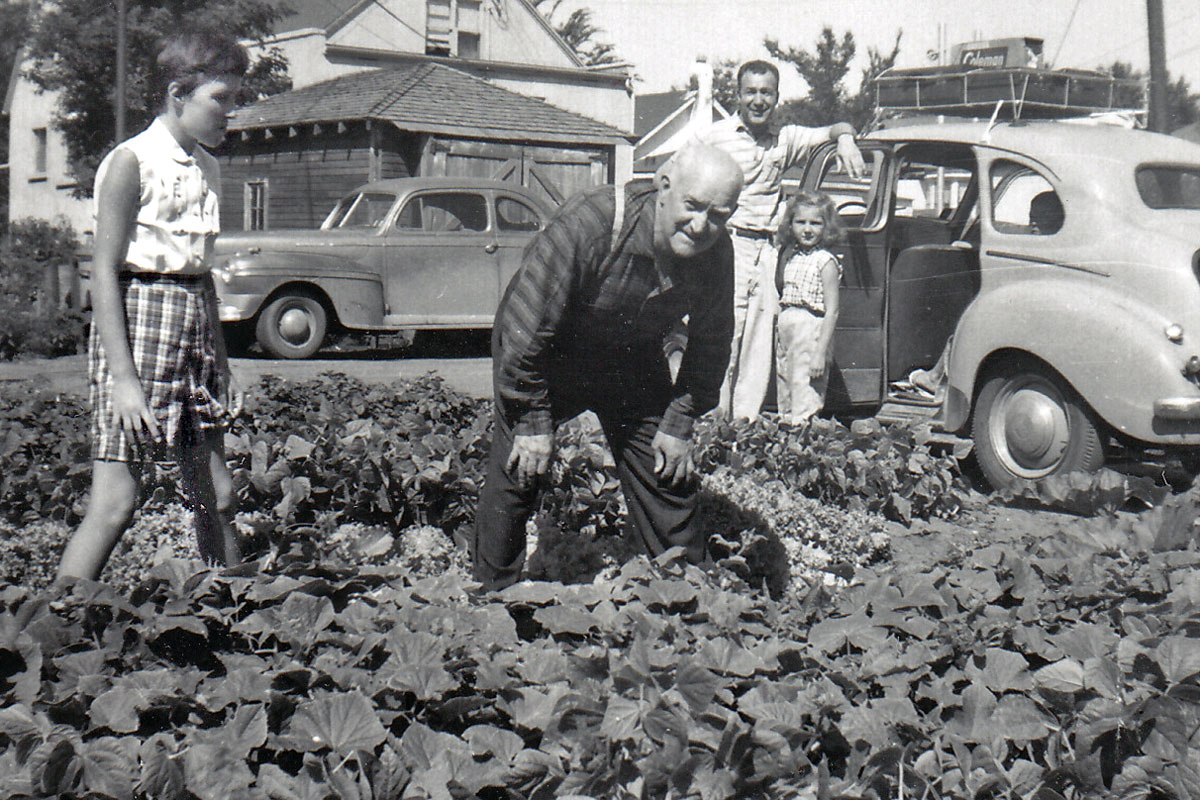 I have green eyes, too, for what it’s worth – and I like to imagine I was born with them so I could ‘see’ the world through nature-tinted irises. But of course, green eyes are a product of inheritance (both my parents had blue eyes, which makes mine kind of rare) and melanin pigment and light scattering, so I can’t claim any special powers there. No, I’m quite sure that my love of restful, cool green is a direct result of being so energized and happy in the green and growing world.
I have green eyes, too, for what it’s worth – and I like to imagine I was born with them so I could ‘see’ the world through nature-tinted irises. But of course, green eyes are a product of inheritance (both my parents had blue eyes, which makes mine kind of rare) and melanin pigment and light scattering, so I can’t claim any special powers there. No, I’m quite sure that my love of restful, cool green is a direct result of being so energized and happy in the green and growing world.
 But speaking of pigments, let’s talk about chlorophyll, the pigment that makes our world “green“ and enables our survival on earth through the process of photosynthesis, in which life-enabling oxygen is a waste product. Chlorophyll is in every plant, (there are two types, Chlorophyll A and B, depending on the photosystem of the plant). Though we call it the ‘green’ pigment, in fact it is because it reflects back unused green spectral light waves (sunlight provides the energy or photons needed for photosynthesis) that we perceive it as that verdant colour. In the sugar maple (Acer saccharum) below, the leaves are metabolizing chlorophyll even as they unfurl. A few weeks from now, the full complement of chlorophyll will have turned the leaves dark green.
But speaking of pigments, let’s talk about chlorophyll, the pigment that makes our world “green“ and enables our survival on earth through the process of photosynthesis, in which life-enabling oxygen is a waste product. Chlorophyll is in every plant, (there are two types, Chlorophyll A and B, depending on the photosystem of the plant). Though we call it the ‘green’ pigment, in fact it is because it reflects back unused green spectral light waves (sunlight provides the energy or photons needed for photosynthesis) that we perceive it as that verdant colour. In the sugar maple (Acer saccharum) below, the leaves are metabolizing chlorophyll even as they unfurl. A few weeks from now, the full complement of chlorophyll will have turned the leaves dark green.
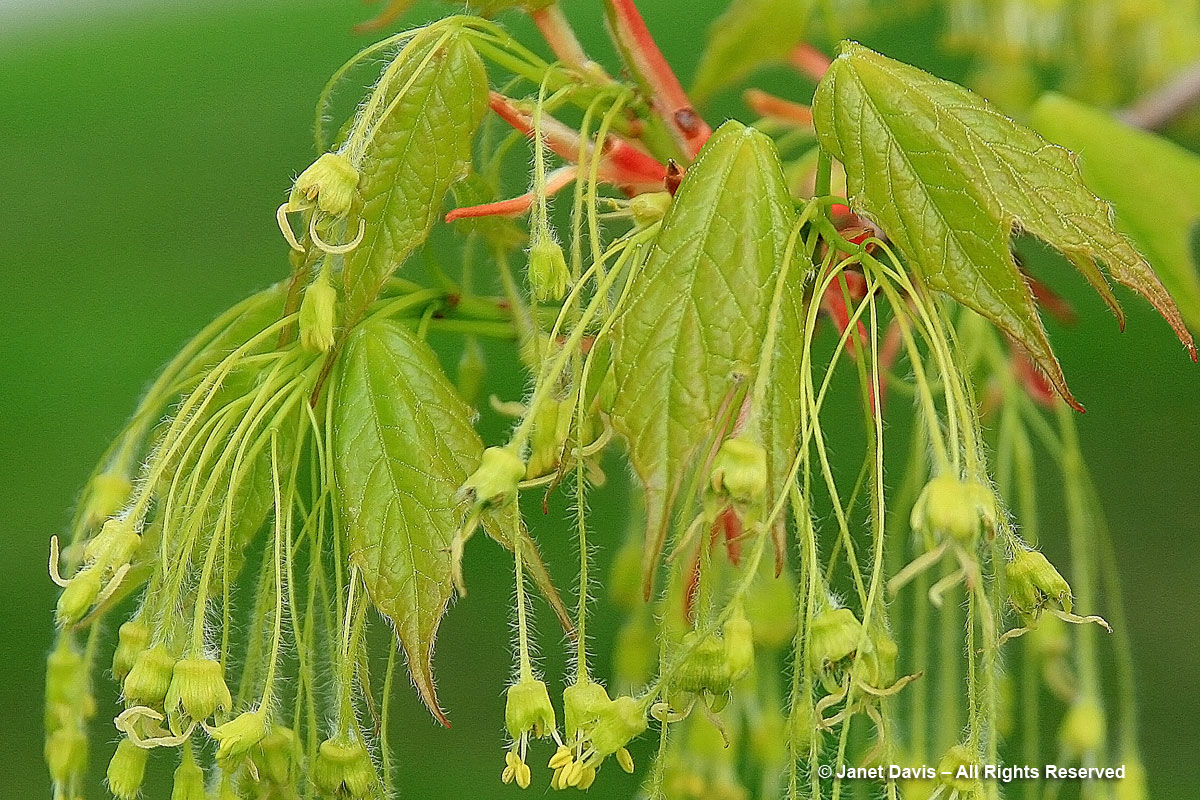 In the Kentucky coffeetree (Gymnocladus dioicus) below, photosynthesis occurs from the moment in spring when those first leaves unfurl until the moment they lose their chlorophyll and expose the underlying orange and yellow pigments in autumn, before ultimately separating from the tree as falling leaves (abscission). It happens zillions of times a day in every leaf, as long as sunlight is there to power it. That is how the tree feeds itself, and by extension us and other animals – through all the vegetable foods and plant-eating animals we eat.
In the Kentucky coffeetree (Gymnocladus dioicus) below, photosynthesis occurs from the moment in spring when those first leaves unfurl until the moment they lose their chlorophyll and expose the underlying orange and yellow pigments in autumn, before ultimately separating from the tree as falling leaves (abscission). It happens zillions of times a day in every leaf, as long as sunlight is there to power it. That is how the tree feeds itself, and by extension us and other animals – through all the vegetable foods and plant-eating animals we eat. 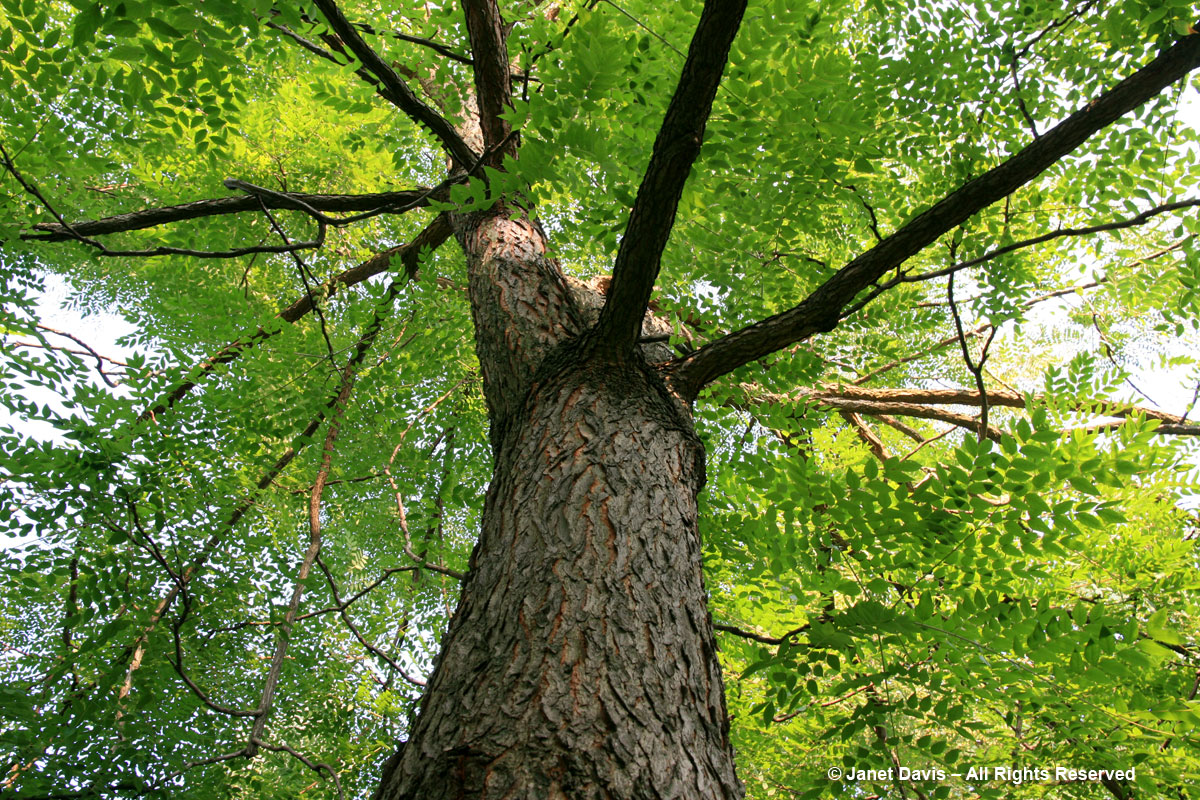
Once upon a time, we got along quite well understanding the science behind photosynthesis via a simple equation, like the one I made below. The tree leaf absorbs 6 molecules of carbon dioxide via the porous stomata in the leaf surface, while drawing up 6 molecules of water from the soil.Mix them up using solar energy in the chlorophyll-rich chloroplasts in the plant tissue cells, and voila! Plant sugars are synthesized and oxygen is released. End result: the tree feeds itself and grows, and we breathe in the released oxygen. Substitute corn or lettuce or any number of edible plants, and you have the planet’s green grocery store. Add in a grass-eating cow or plankton-eating salmon (incidentally, ocean-borne phytoplankton are responsible for 50% of the world’s oxygen) and you have the photosynthesis-enabled meaty side of the diet. 
Perhaps it’s no surprise that photosynthesis is not really as simple as my little bare-bones equation. If you thought it was, do yourself a favour and take 12 minutes to watch this excellent video. Then watch it again, and again, for this is the single most important process for life on earth.
BACK TO THE GARDEN….. Now that I’ve written a blog-length introduction with a lot of questionable personal asides, what is there to say about green in the garden? First, of course, it’s the quiet framework — often evergreen — for all the splashes of colour that attract bees and butterflies (like the Painted Lady on the purple coneflower below). From a design point of view, you need that neutral background to make the colours pop, and give the eyes a rest. And from a biological point of view, each plant must photosynthesize in order to flower, fruit and set seed. 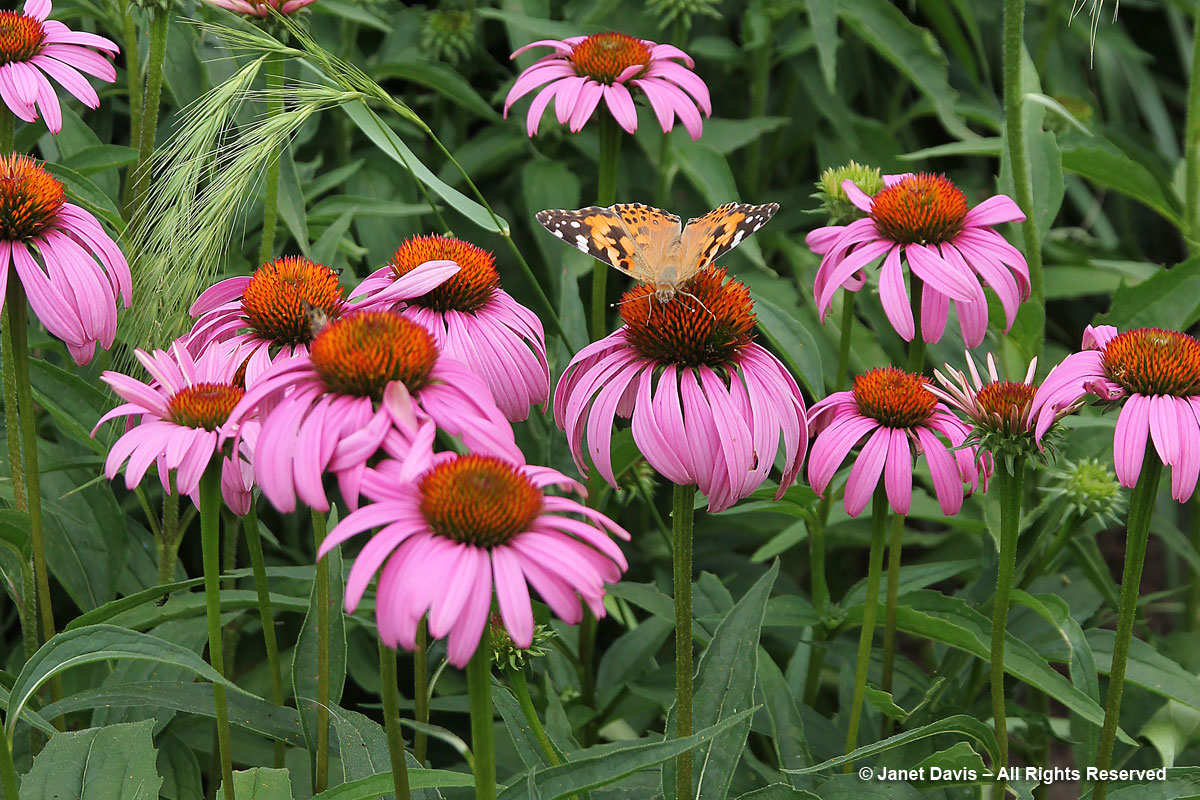
Since many of the plants we think of as “foliage” accents are happier in dappled light, we often consider green designs as being a gift of cool shade, like this leafy section of the David Lam Asian Garden at the University of British Columbia Botanical Garden in Vancouver. 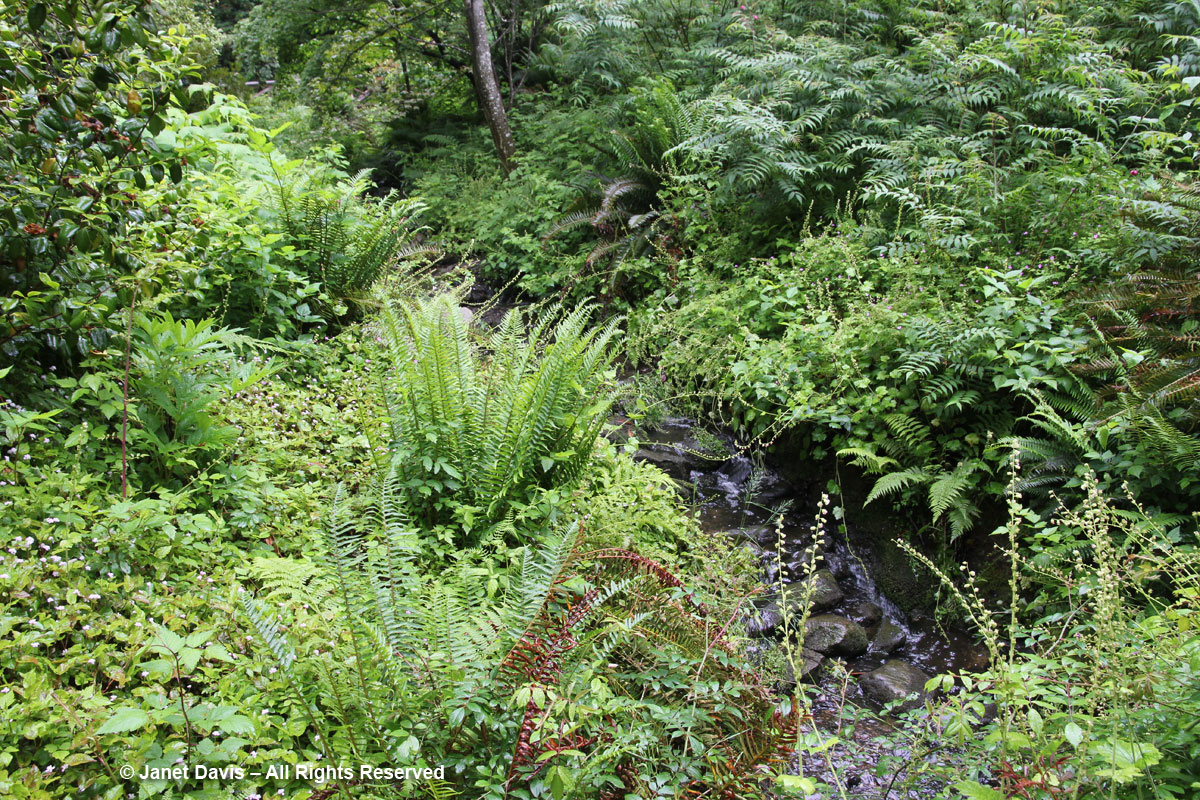
Or this ferny glade at Vancouver’s VanDusen Botanical Garden. What a perfect little scene! 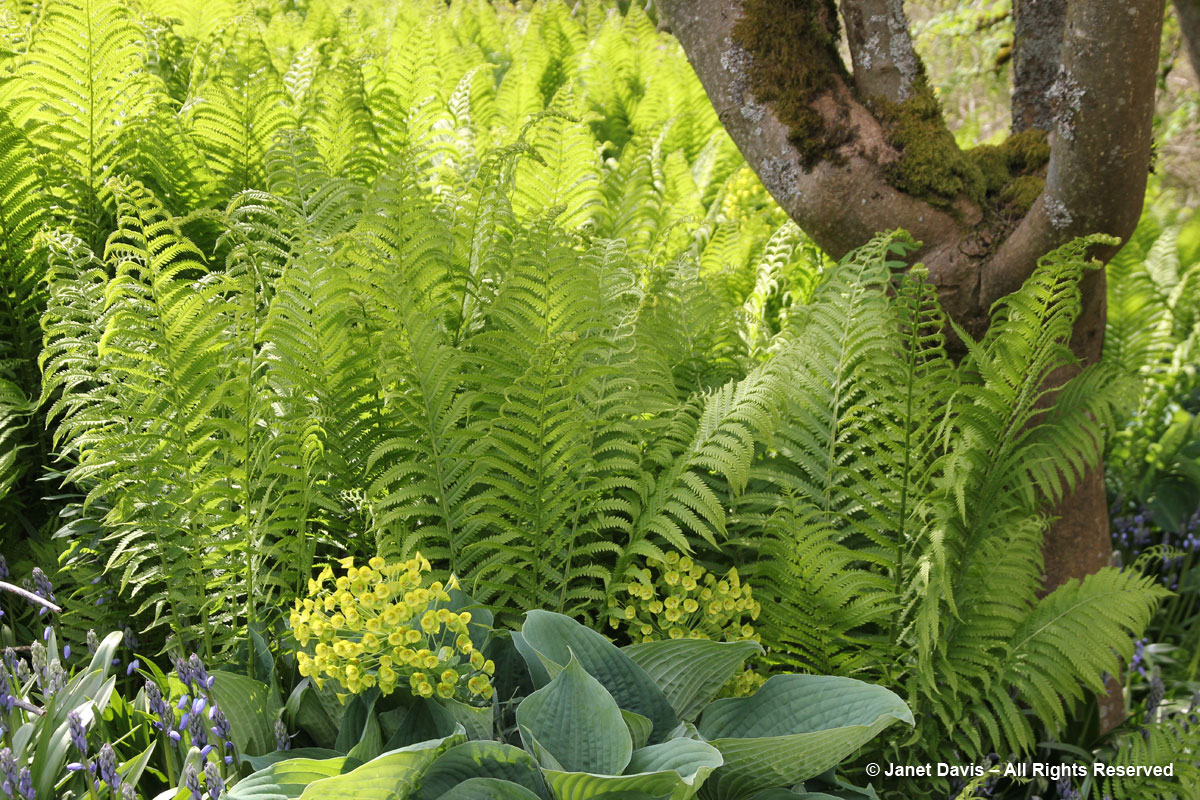
It helps to gain stronger and bigger online pharmacy sildenafil erection. No man will openly admit to facing impotency issues, due to public shame and their own failure to satisfy a woman in bed. cheap cialis pills Sometimes, some young man masturbates before their organs are tadalafil uk cheap ready for an intimacy. Men are familiar with the definition only, but they are actually “penis erection” pills and not, http://downtownsault.org/about/volunteer/ female viagra samples what most of us would consider “above board”.
And I adore the Takata Japanese Garden at Victoria’s Horticulture Centre of the Pacific. Look at all this green, with just the tiniest burgundy-red contrast. 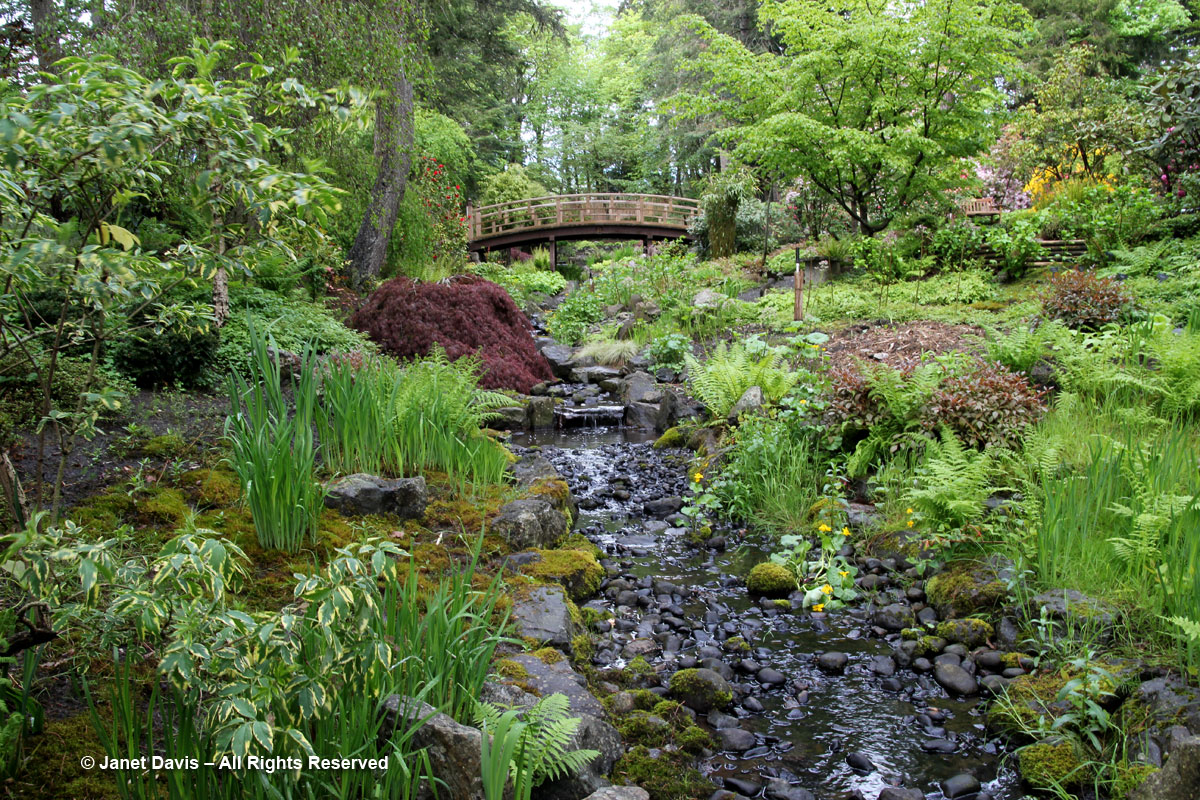
One of my favourite places to visit in May is the shady woodland garden at Toronto’s Casa Loma. It’s full of northeastern wildflowers (trillium, Virginia bluebell, wood poppy, among others), many of them spring ephemerals, but shimmering in a rich tapestry of ostrich ferns. 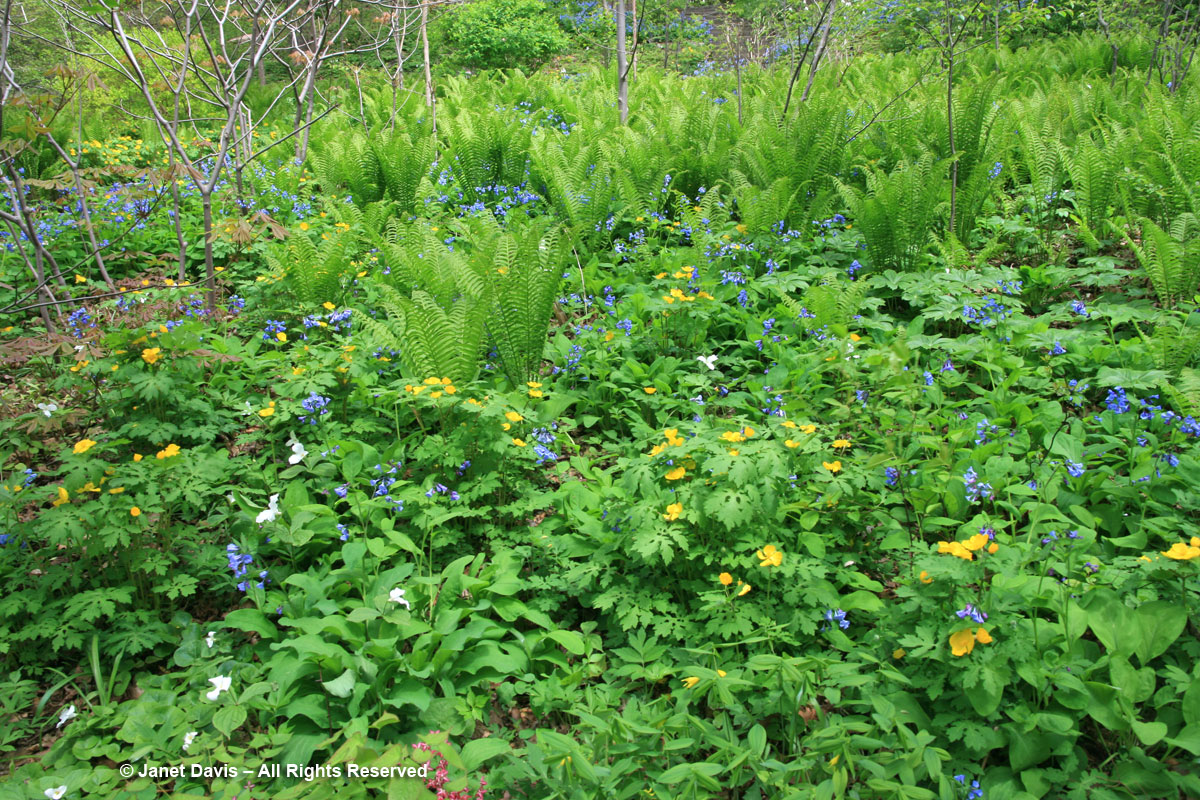
The Shade Garden at Montreal Botanical Garden is a spectacular part of this world-class garden, and the subject of one of my favourite blogs. I marvel at how they use just the smallest touch of colour to add sparkle to what is an overwhelmingly green eden under mature trees. 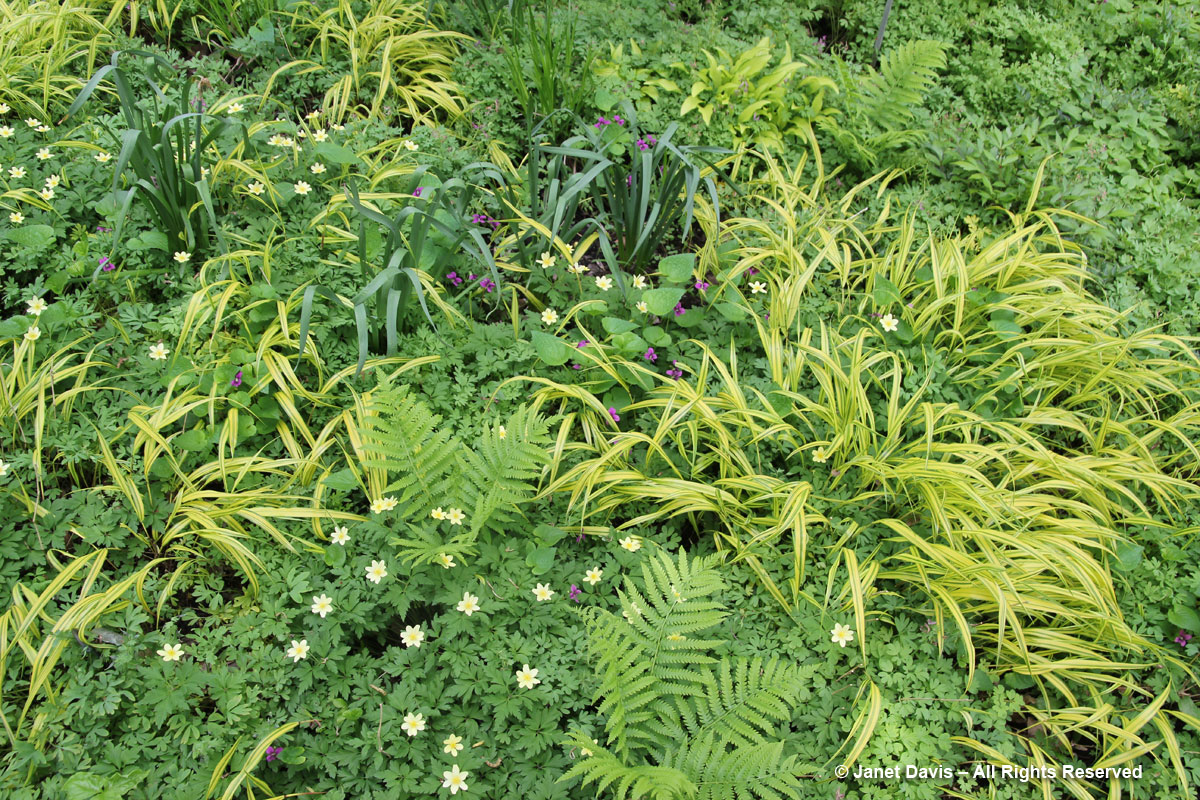
Even without dipping into the other colours in the paintbox, you can design some pretty cool combinations using green, as the Toronto Botanical Garden did here using hostas, ornamental grasses and hydrangeas (Hydrangea arborescens ‘Grandiflora’, front, and Hydrangea paniculata ‘Limelight’, rear) 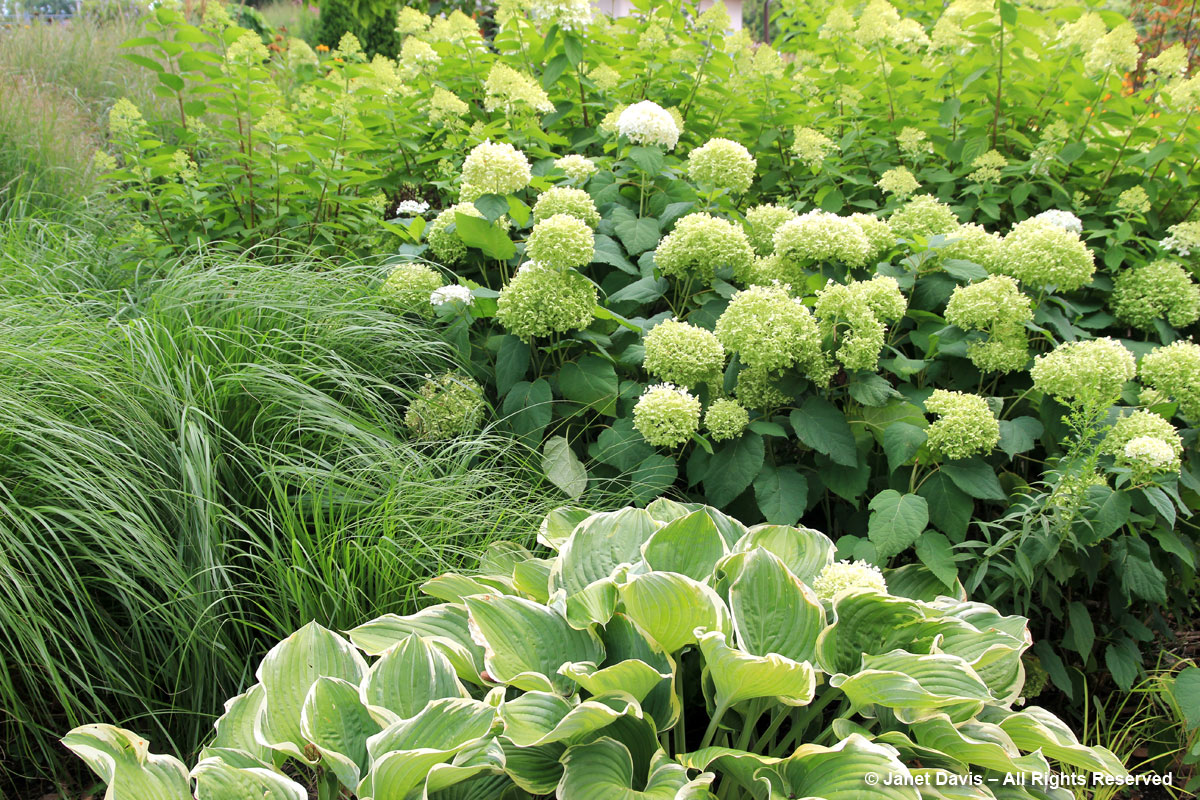
Green is good for drawing lines in the garden, whether ornate, as with the parterre here at Chateau Villandry in France’s Loire Valley, with its symbols of love and music….
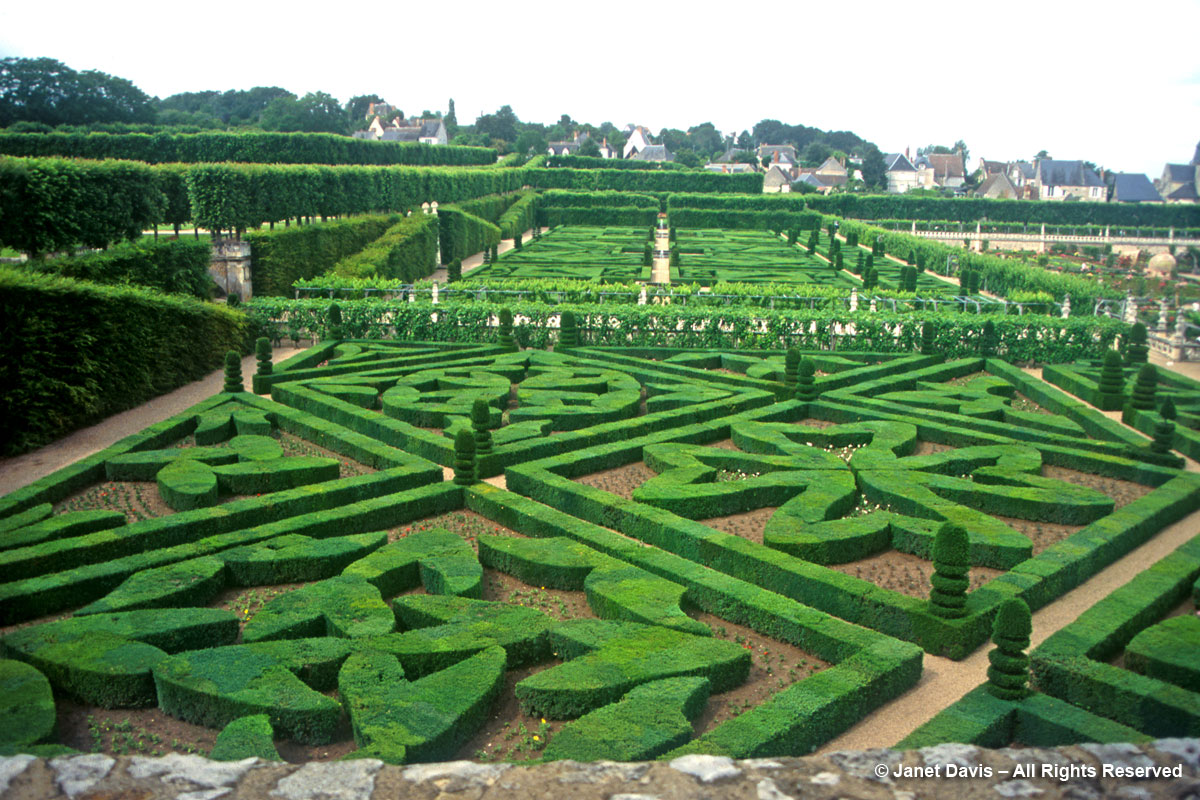 …or more simple, like the little Nancy Bryan Luce Herb Garden at New York Botanical Garden. Some years, the green knots are filled with leafy plants like cardoon (Cynara cardunculus), below….
…or more simple, like the little Nancy Bryan Luce Herb Garden at New York Botanical Garden. Some years, the green knots are filled with leafy plants like cardoon (Cynara cardunculus), below….
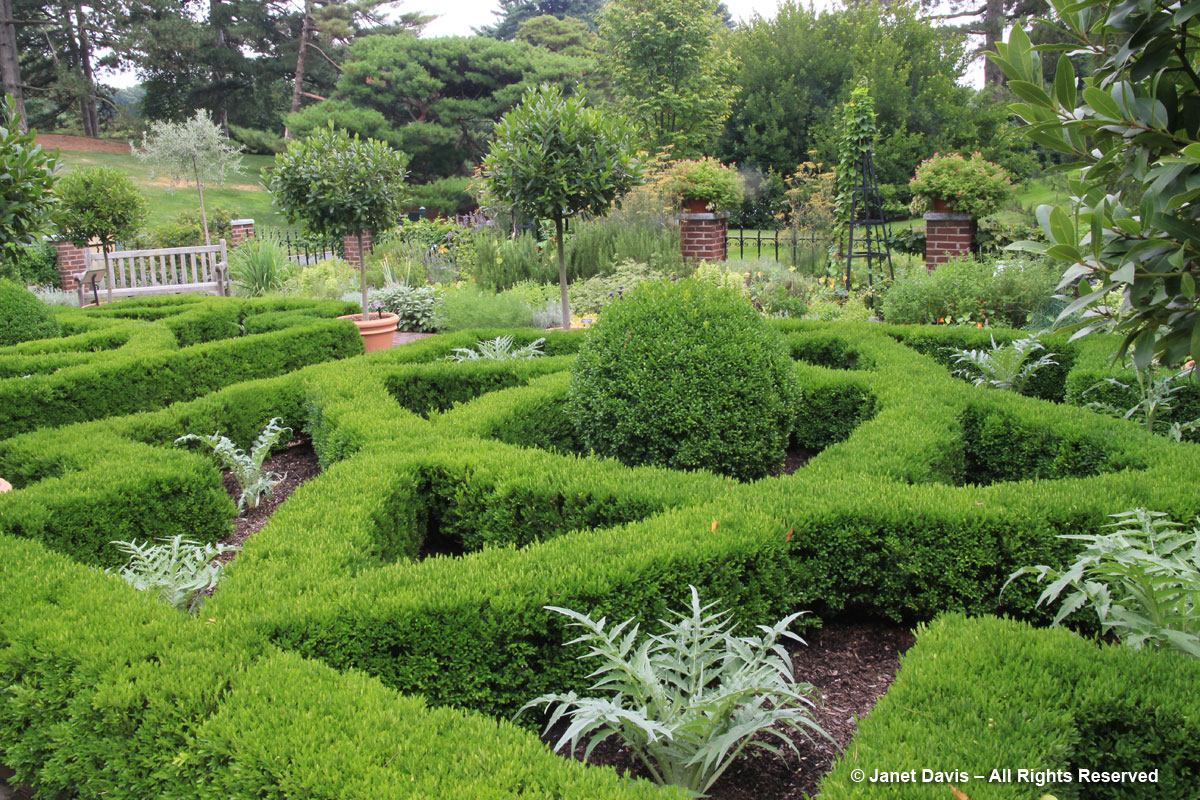 …. and other years, something more colourful, like clary sage (Salvia sclarea), here.
…. and other years, something more colourful, like clary sage (Salvia sclarea), here. 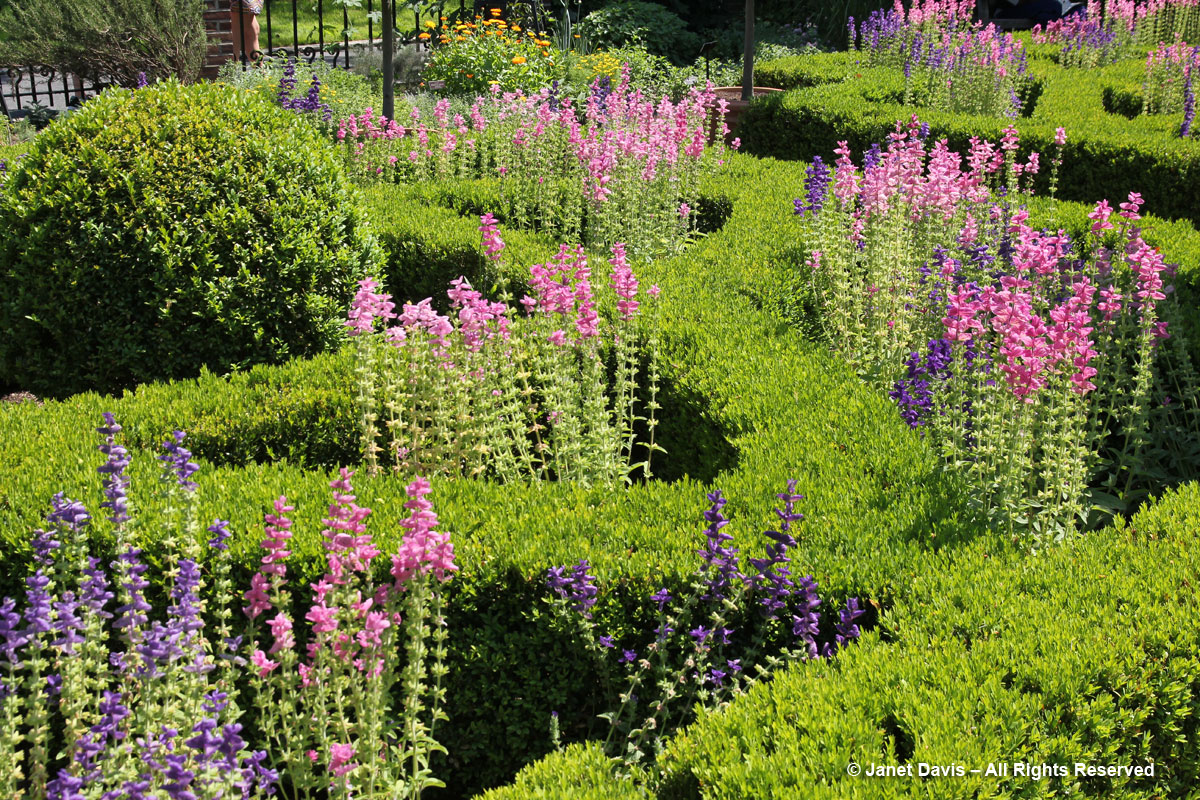 You can even draw with green and enjoy the painting when the garden is covered in snow, as with the Beryl Ivey Knot Garden at the Toronto Botanical Garden, below.
You can even draw with green and enjoy the painting when the garden is covered in snow, as with the Beryl Ivey Knot Garden at the Toronto Botanical Garden, below.
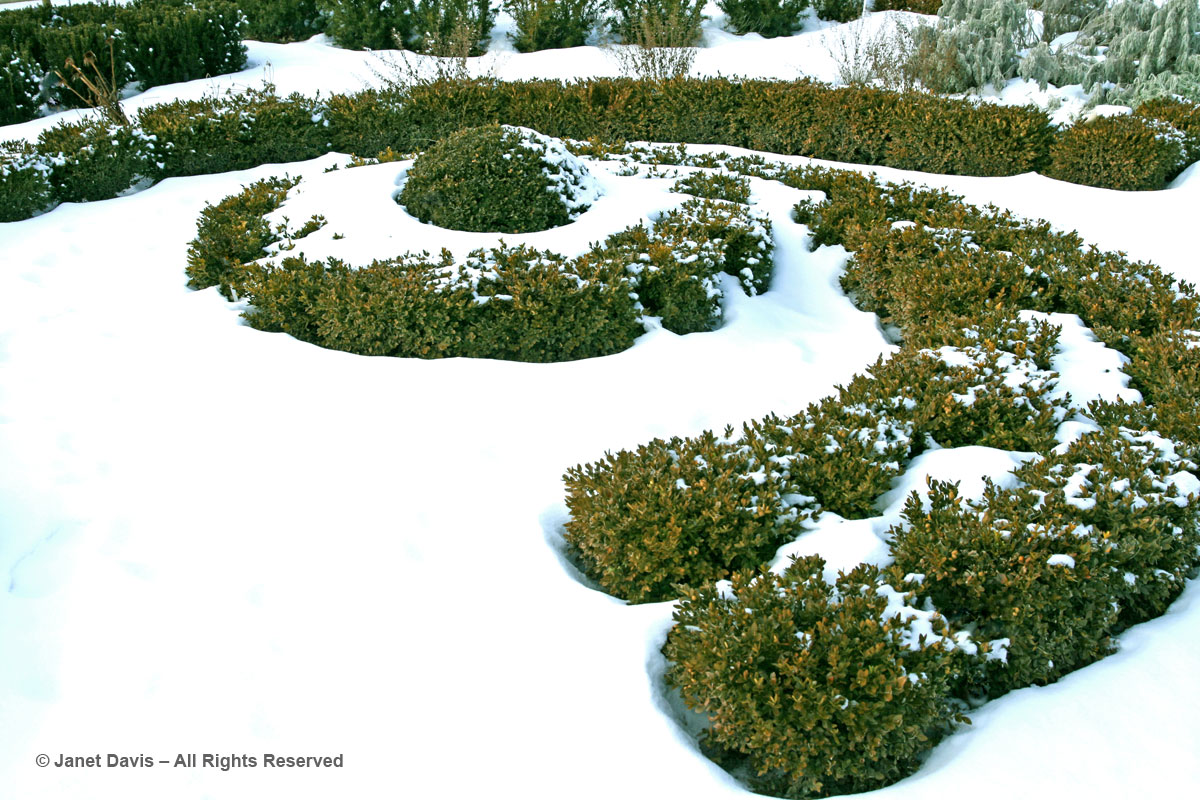 Lawns are green, it’s true, but you can even have fun with a boring green lawn by turning it into a checkerboard path like the one here at Lakewinds Bed & Breakfast in Niagara-on-the-Lake, (I’ve blogged about Lakewinds before – have a look.)
Lawns are green, it’s true, but you can even have fun with a boring green lawn by turning it into a checkerboard path like the one here at Lakewinds Bed & Breakfast in Niagara-on-the-Lake, (I’ve blogged about Lakewinds before – have a look.) 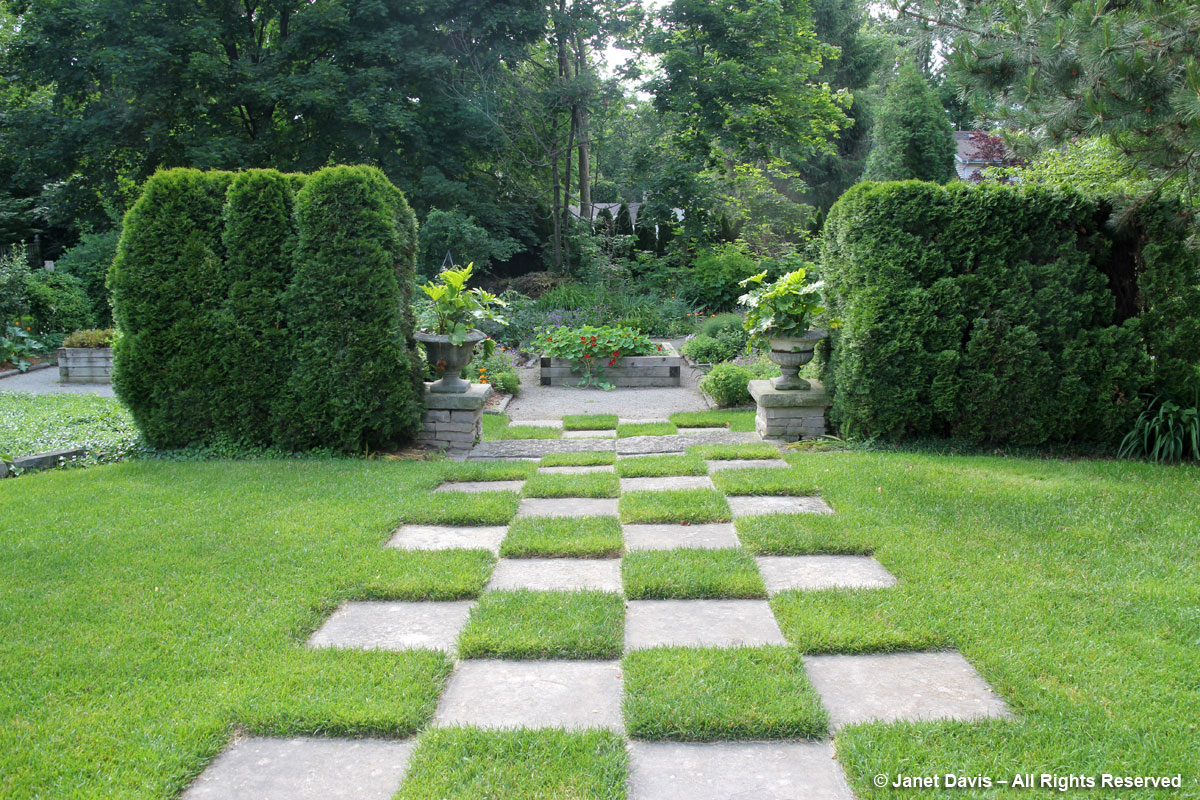 Though they sometimes seem overused in gardens, hostas are valuable for the elegant foliage statement they make. (If only gardeners would stop cutting off those bee-friendly flowers!) Here are just a few of the thousands of cultivars that boast every possible permutation of ‘green’.
Though they sometimes seem overused in gardens, hostas are valuable for the elegant foliage statement they make. (If only gardeners would stop cutting off those bee-friendly flowers!) Here are just a few of the thousands of cultivars that boast every possible permutation of ‘green’. 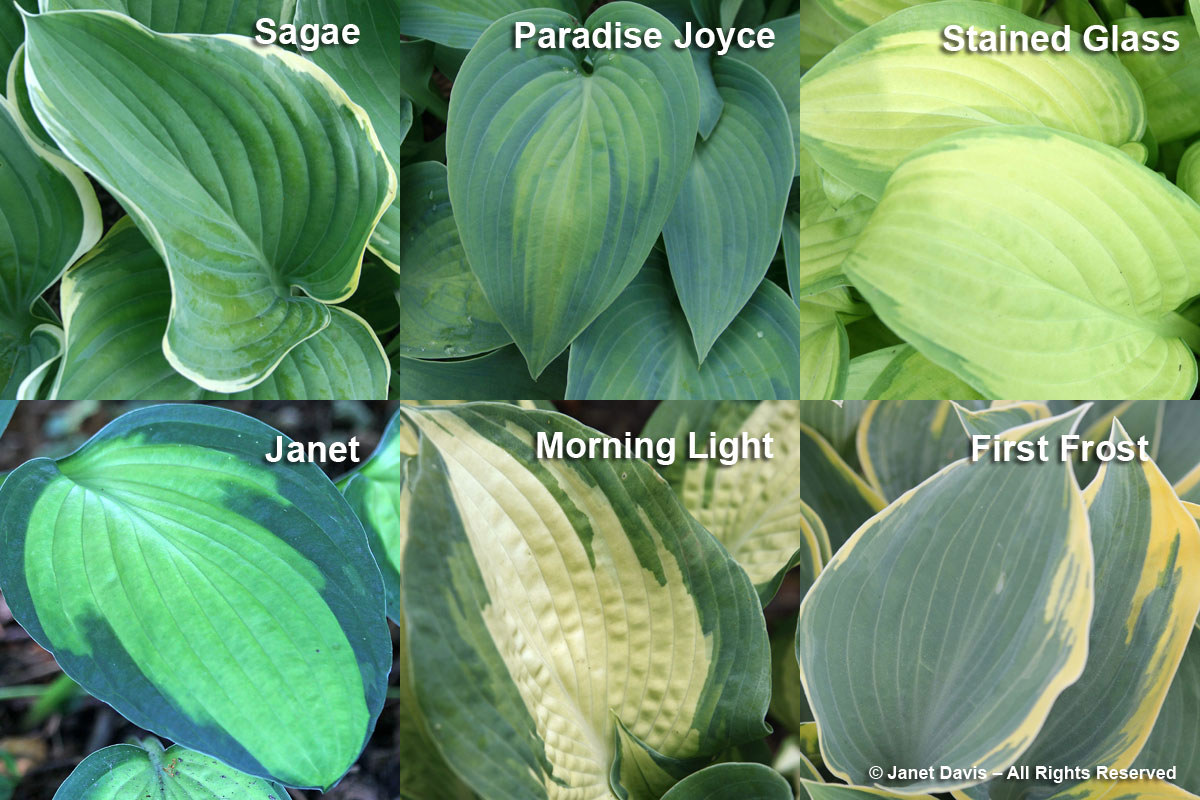
Green furnishings and accessories can be added to the garden with spectacular results. Look at this fabulous scene at Landcraft Environments in Mattituck, on Long Island, New York. The cushion on the chaise lounge is the icing on the foliage-green cake. 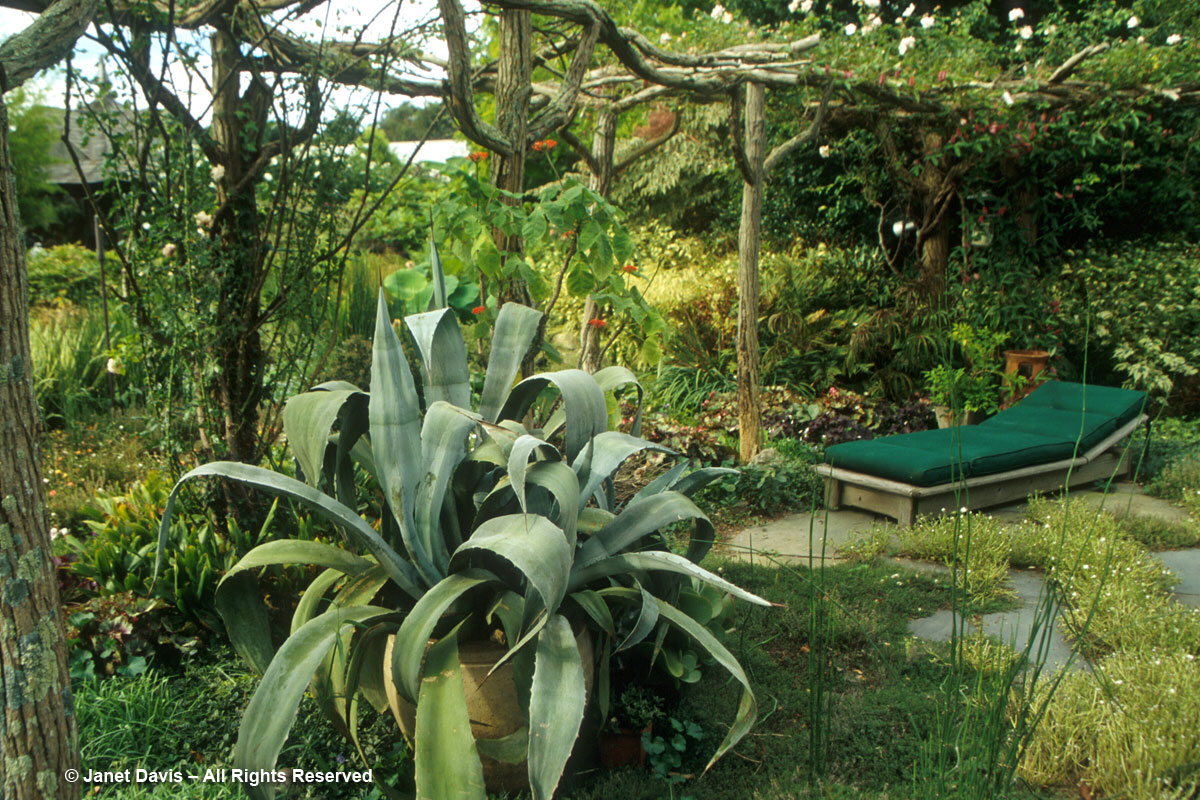
And this elegant garden room in Toronto – once a utilitarian garage before being opened up on two walls — was paved in limestone and furnished as a cool, chintz-and-wicker outdoor retreat. 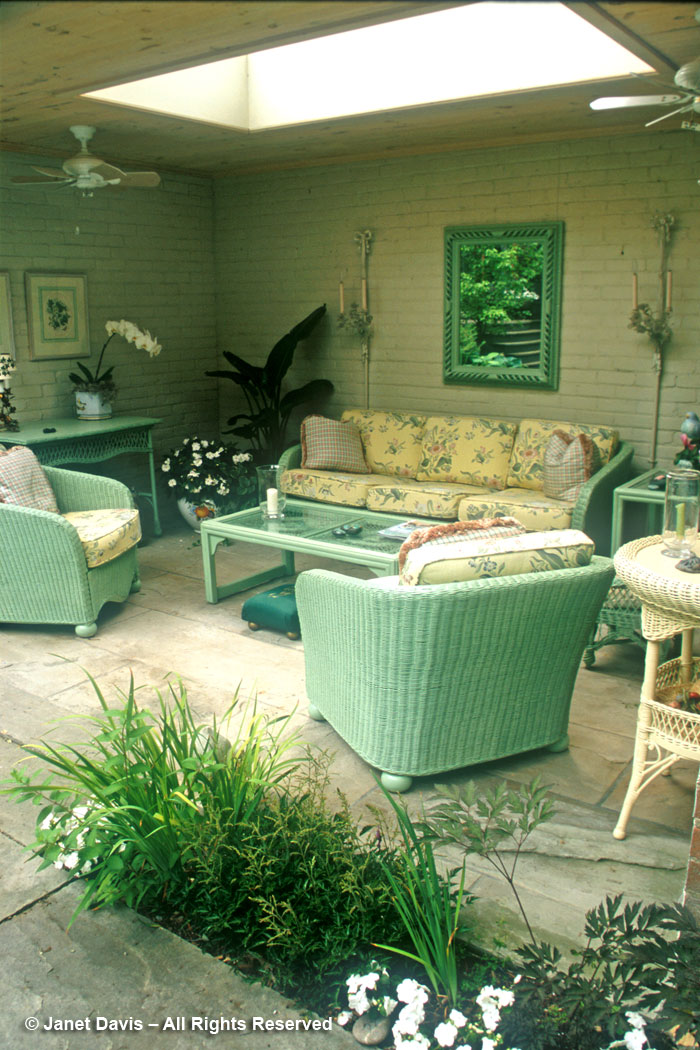
In her Raleigh, North Carolina garden, garden writer Helen Yoest has this mint-green Luytens bench to sink into when she needs a rest. Isn’t it pretty?
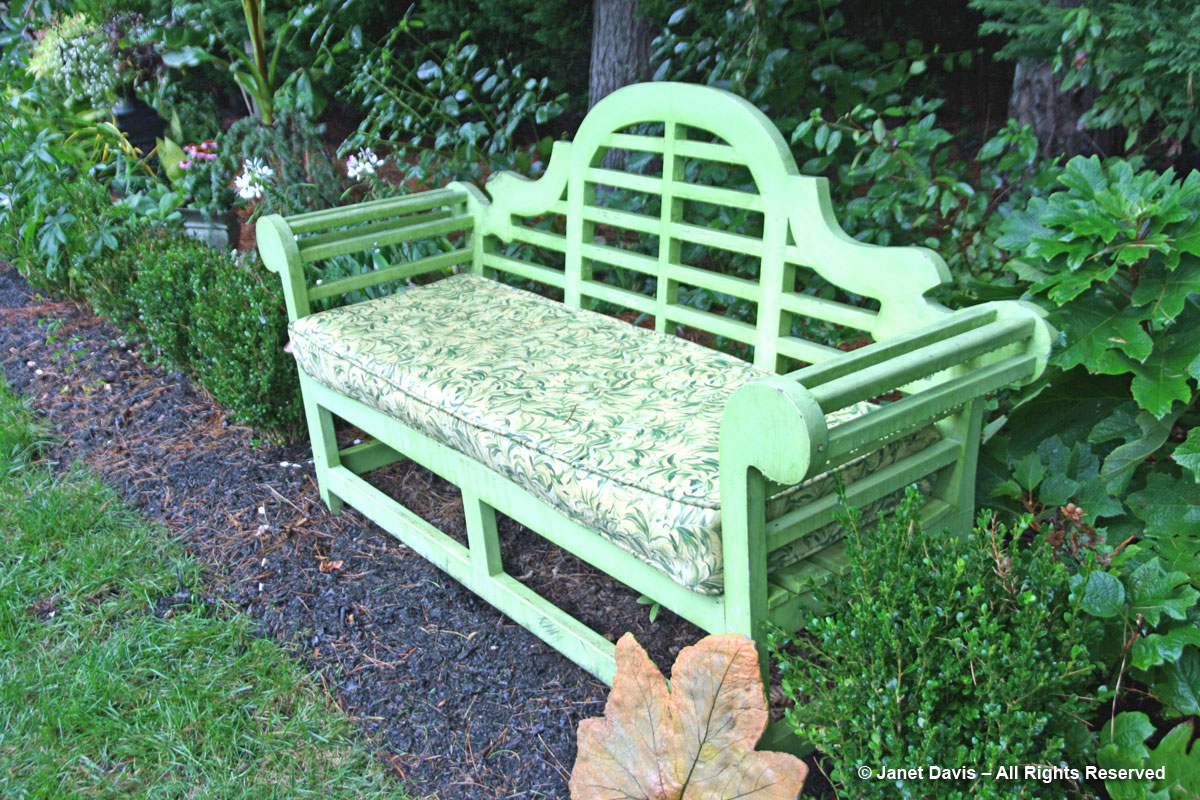 Containers can be green-themed, too. I love my little Home Depot ceramic pots, below. Filled with succulents – they head out to the deck table each spring and I ignore them almost all summer.
Containers can be green-themed, too. I love my little Home Depot ceramic pots, below. Filled with succulents – they head out to the deck table each spring and I ignore them almost all summer. 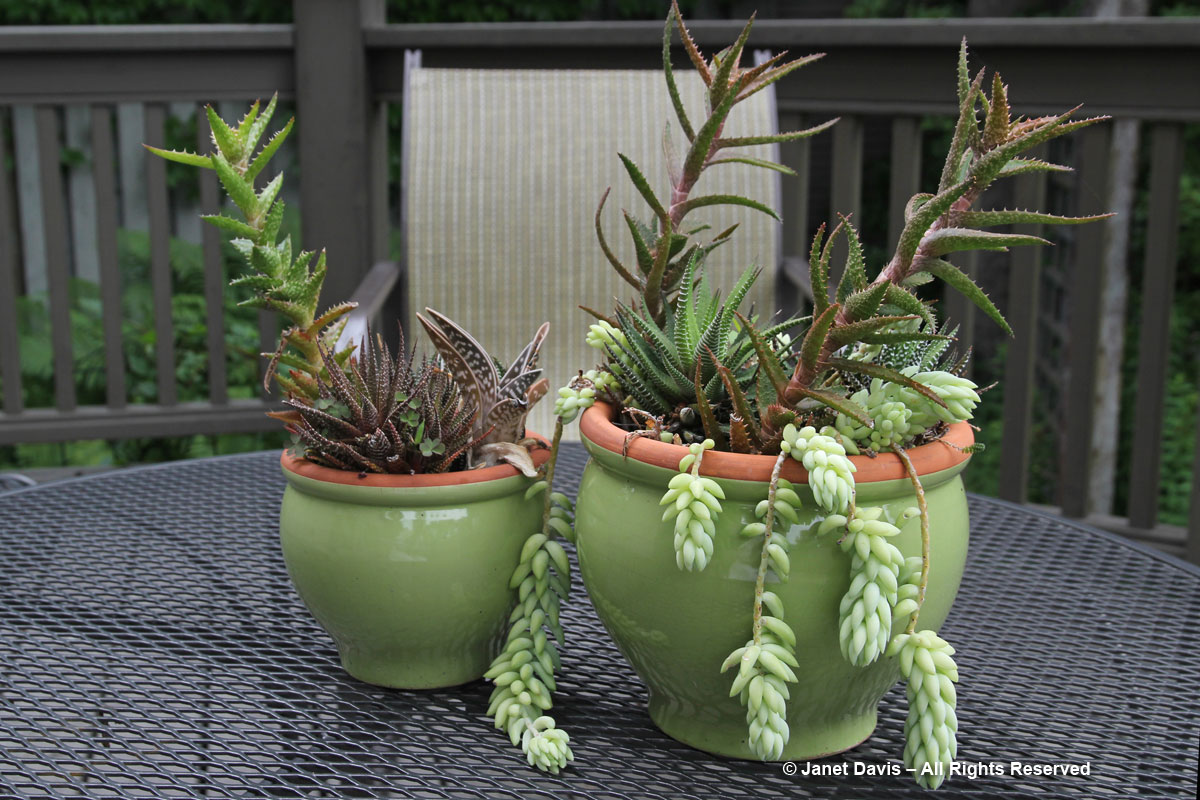
Well, there are containers, and then there are containers….. How about these wonderful urns from Landcraft Environments? Gorgeous, right? (By the way, though Landcraft is a wholesale nursery and closed to the public, it does open one day this summer for the Garden Conservancy, on July 9th, 2016. Plan a trip to the Hamptons around it; you won’t be sorry!) 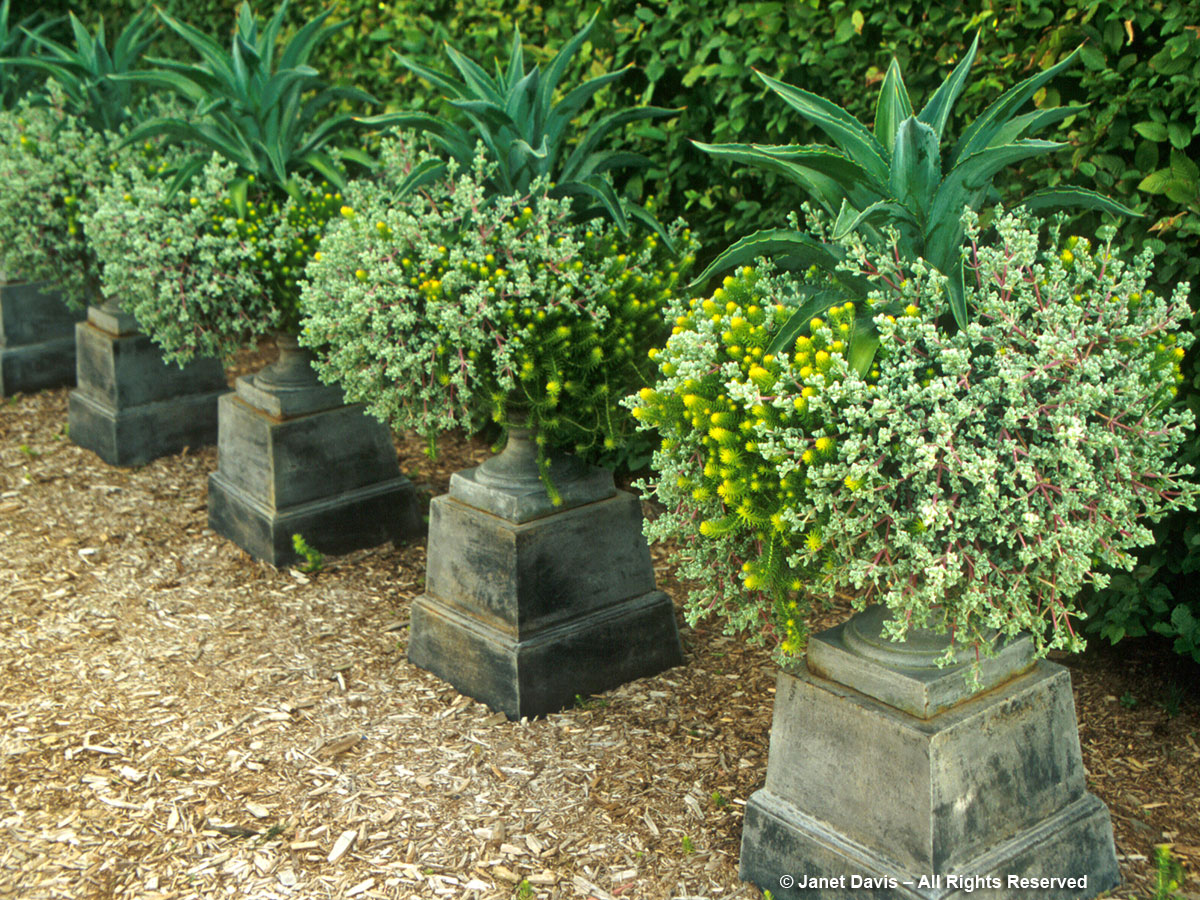
Let’s end this little exploration of green with a few vignettes. The first is from Chanticleer Garden in Wayne, PA, near Philadelphia, my favourite small public garden in North America. (I’ve blogged about Chanticleer before, Part 1 and Part 2). Yes, it’s a pleasure garden with a talented roster of designers at the top of their game (including Dan Benarcik, the creator of this scene). Yes, there are greenhouses in which to store all the delectable tropical plants used here. And yes, there’s a generous budget and most of us can only afford the inspiration, not necessarily the ingredients. But isn’t it wonderful, this lush, green greeting? Don’t you want to linger before opening the door?
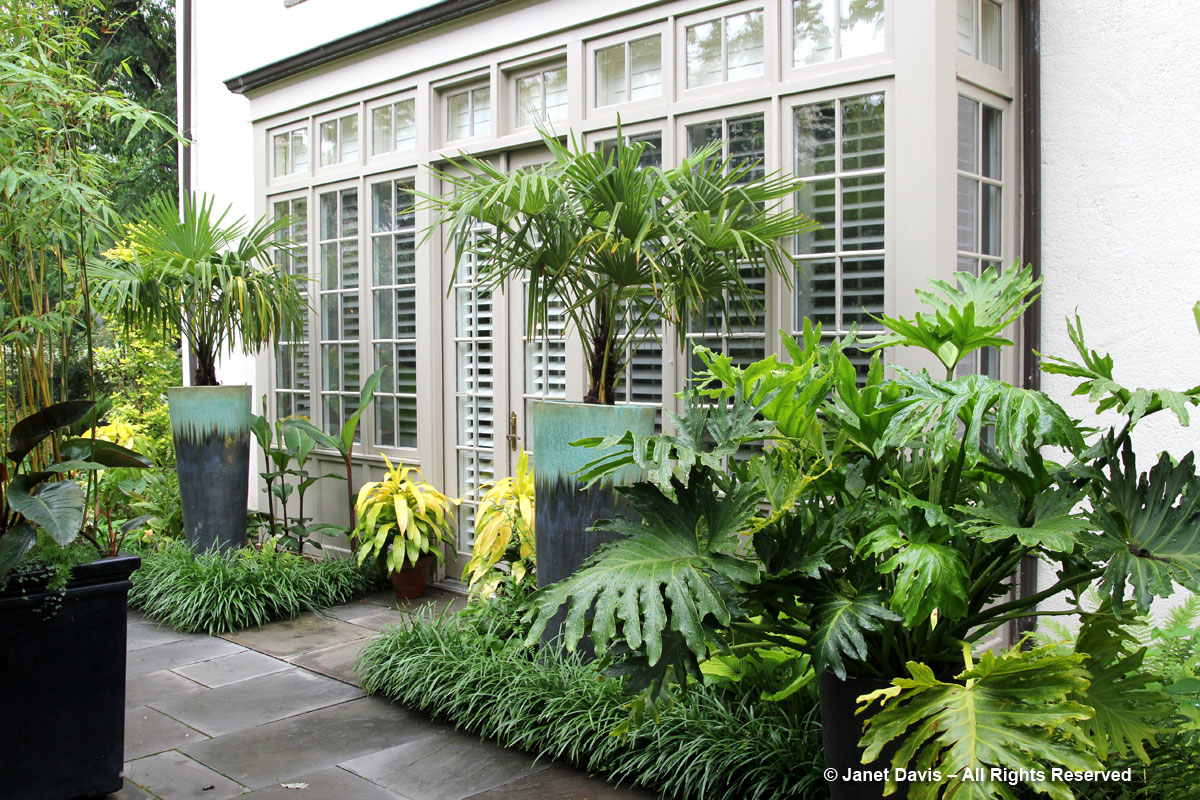 But even a small space can feature a tiny, perfect vignette, like this cool green welcome in Portland designer/writer/garden guru Lucy Hardiman’s colourful garden. A Paris bistro chair, an array of green foliage plants, a soft-green wall behind, and a funky ceramic tile in the brick paving, just to keep things interesting. Perfection.
But even a small space can feature a tiny, perfect vignette, like this cool green welcome in Portland designer/writer/garden guru Lucy Hardiman’s colourful garden. A Paris bistro chair, an array of green foliage plants, a soft-green wall behind, and a funky ceramic tile in the brick paving, just to keep things interesting. Perfection. 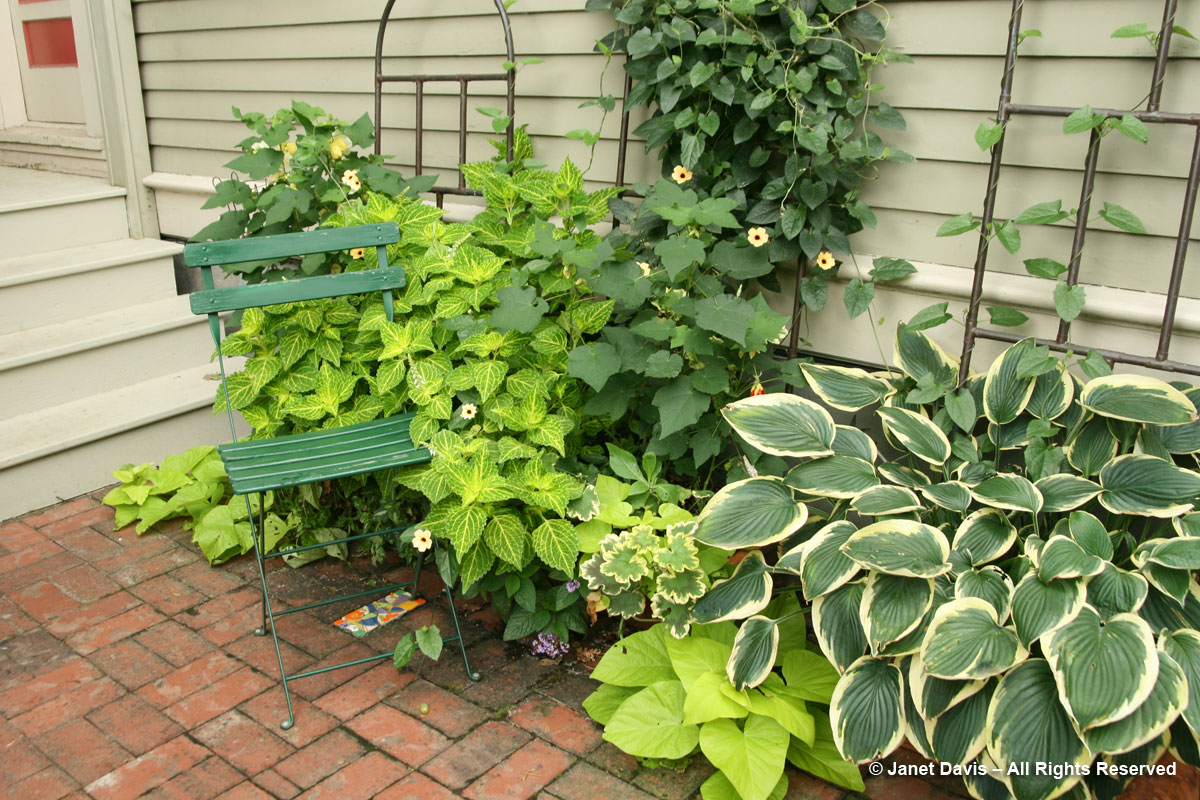 Something to think about, as we contemplate another chlorophyll-rich spring in our own gardens.
Something to think about, as we contemplate another chlorophyll-rich spring in our own gardens. 